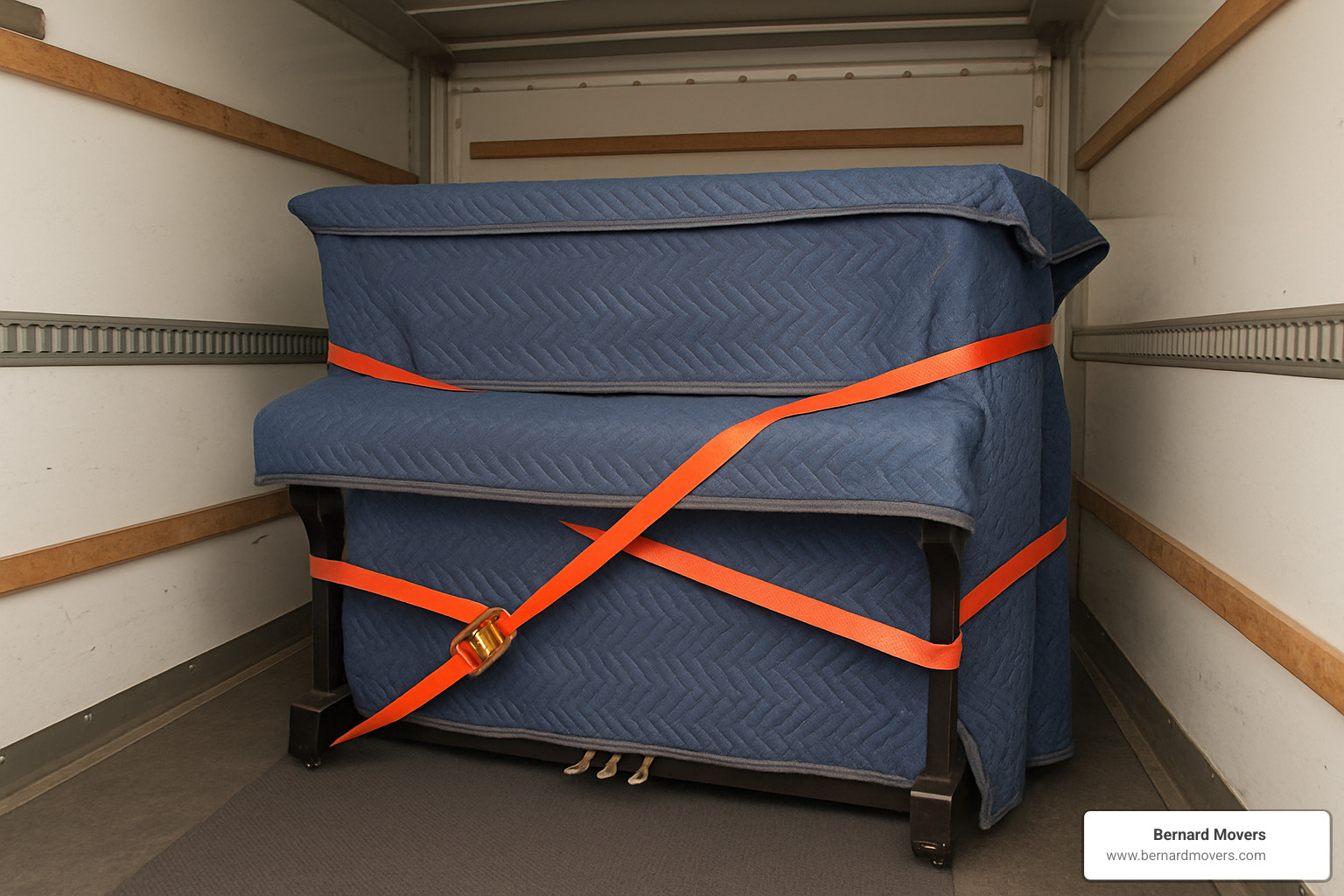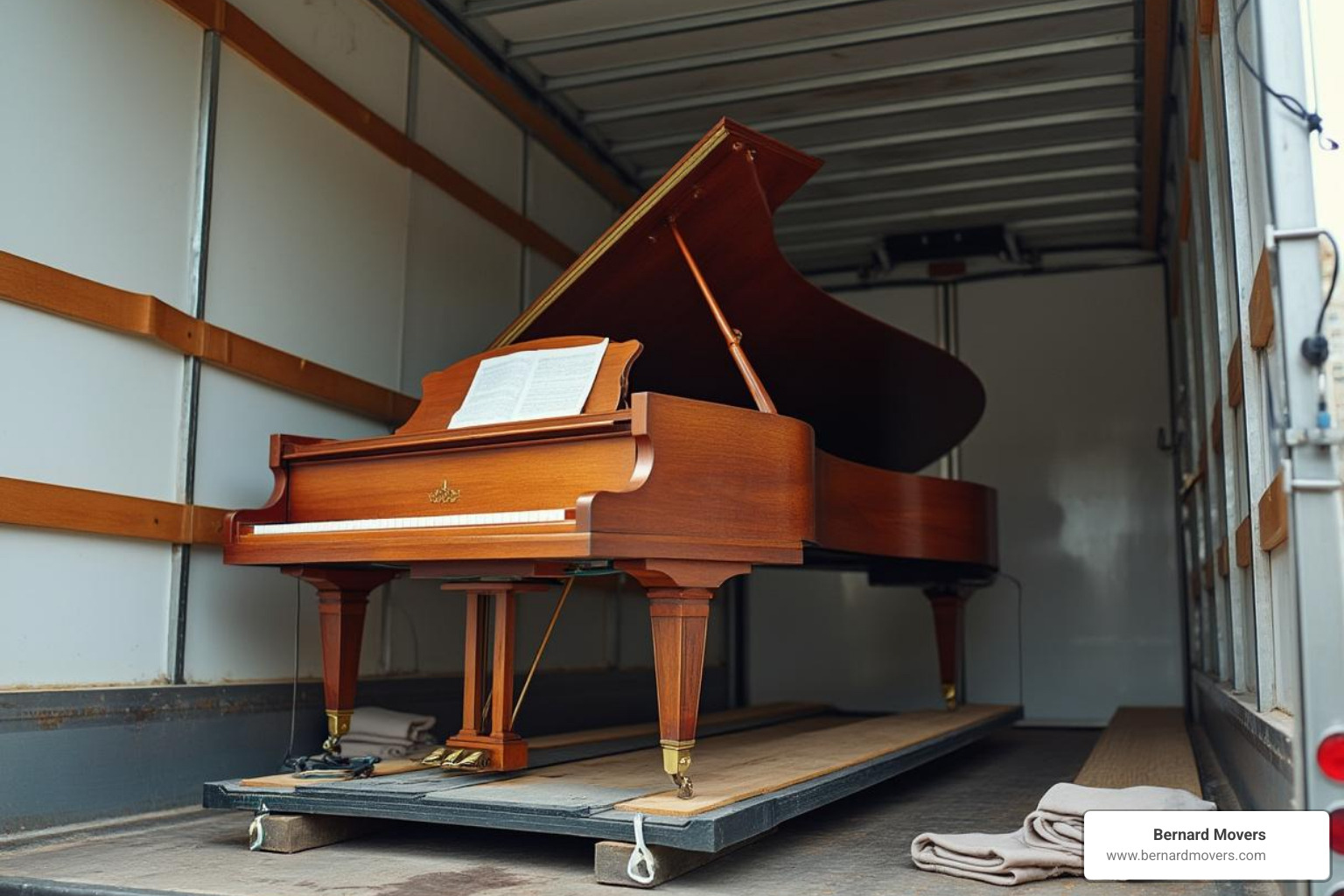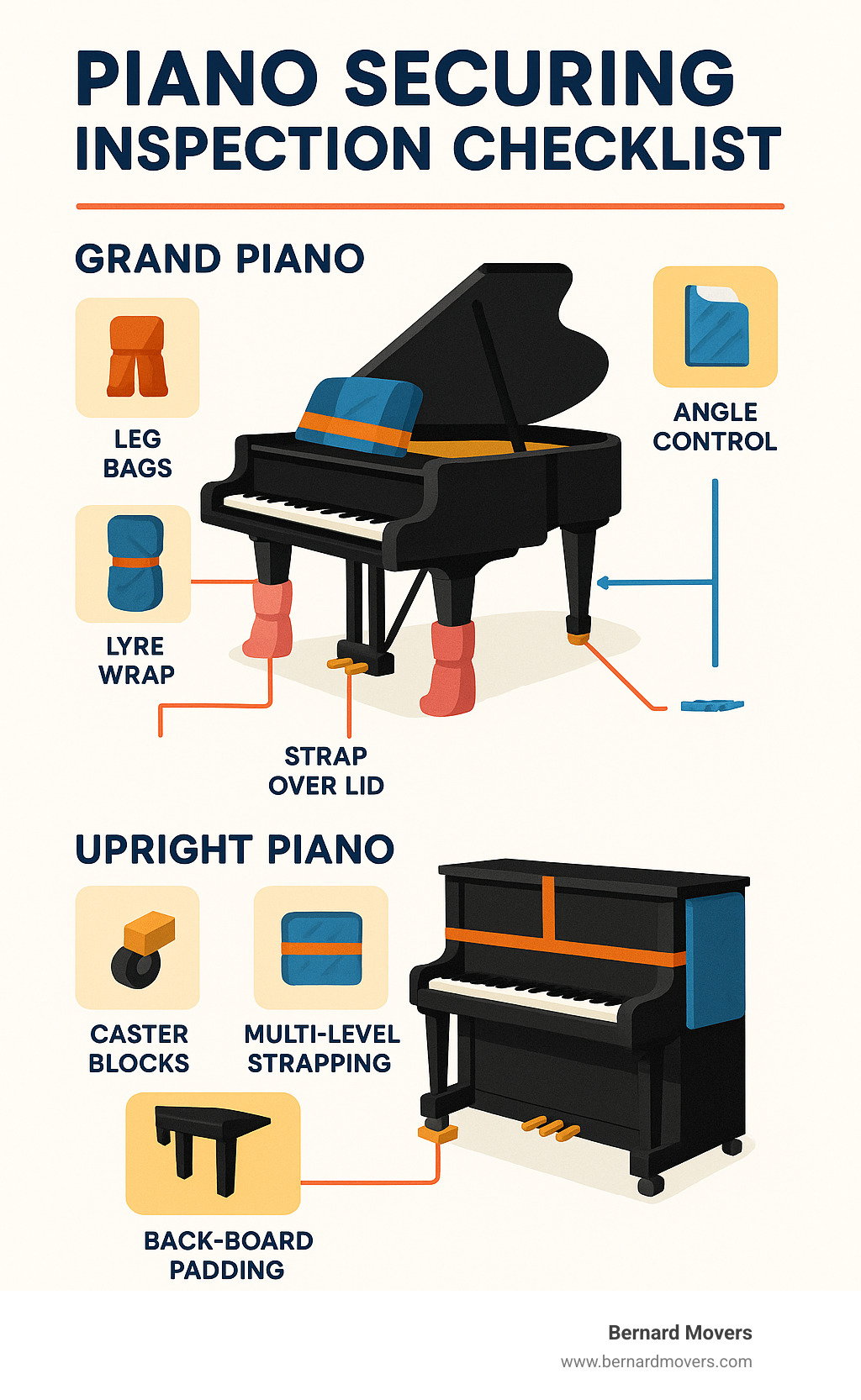How to Secure a Piano in a Moving Truck: The Fastest Answers Up Front
How to secure a piano in a moving truck—here’s what you need to know in 30 seconds:
- Wrap the entire piano in thick moving blankets and secure with stretch wrap or tape.
- Use a 4-wheel piano dolly to move it safely up the ramp.
- Position the piano against the truck’s front or side wall—never in the center or near the door.
- Strap the piano tightly to the wall using at least two heavy-duty ratchet straps (attach to built-in anchor points, at different heights).
- Place extra padding between the piano and any truck walls or other items to prevent scratches.
- Double-check that nothing can shift, tip, or roll before driving.
The basics: Use the right equipment, keep the piano snugly tied down, and cushion every surface.
Moving a piano isn’t just about muscle—it’s about using the right strategy to protect both your cherished instrument and your moving team. Pianos are heavy, awkward, and surprisingly delicate, making careful securing inside the truck essential to prevent costly damage or accidents.
Moving a piano is so tough, it has carved its own niche in the moving industry.
My name is Mina Georgalas, owner of Bernard Movers. With over 50 years of family expertise, I’ve helped thousands learn how to secure a piano in a moving truck—from upright models to concert grands—and have seen every mistake (and best practice) along the way. Let’s break it all down, step by step.

Related content about how to secure a piano in a moving truck:
– how to pack an upright piano for moving
– how to disassemble an upright piano for moving
– how to make a piano moving dolly
The Stakes: Why Proper Piano Securing Matters
Let’s put it plainly: pianos are massive, awkward, and a little bit sneaky. An upright piano can weigh anywhere from 300 to 800 pounds. Grand pianos? Those can tip the scales at a jaw-dropping 1,400 pounds. Think of moving a small car—except your “car” is top-heavy, fragile, and has a knack for tipping if it isn’t locked down just right.
Here’s the thing about pianos: their weight isn’t spread out like your average sofa. Most of that heft is up high, which means the piano wants to tip, especially when you turn, brake, or hit a bump. If you don’t know how to secure a piano in a moving truck the right way, you’re putting yourself, your helpers, and your instrument at risk. It’s not just about scratches—if a piano shifts when you hit the brakes, it can turn into a 1,000-pound battering ram. As one veteran mover put it, “If this piano isn’t secured, it can launch forward and crush anything in its path.”
Beyond the obvious safety dangers, there’s a hidden world of costs that come with a loose piano in transit. If your piano starts to slide, it can gouge up the truck floor, leave deep marks on your home’s hardwood, or destroy door frames. Even a small shift can lead to back injuries or worse, especially if someone tries to stop it. And let’s not forget about the little things—after a bumpy ride, you’ll likely need a professional tuning (which can run $100 to $200), and visible dings or tweaks can drop your piano’s resale value by thousands.
Insurance is another concern. If your piano is damaged because it wasn’t properly secured, there’s a good chance your claim will be denied. That’s not a risk you want to take.
We see too many DIY movers skip key steps, thinking, “It’ll be fine.” But the repair costs, the potential for injury, and the hassle of lost value are real. That’s why professional movers always use at least two or three strong ratchet straps, anchored at different heights, with plenty of thick padding.
Taking time to secure your piano the right way pays off the moment you hit your first sharp turn or sudden stop. Your instrument stays safe, your team avoids injuries, and your wallet thanks you later.
Want to know more about prepping your piano before loading? Check out how to pack an upright piano for moving for packing tips that make all the difference.
Prepping the Piano and the Pathway
Here’s the truth about how to secure a piano in a moving truck: the real work starts long before you even touch the truck. This prep phase is where smart movers separate themselves from the “let’s wing it” crowd—and trust me, you don’t want to be in that second group.
Measure everything twice, move once. Start with your piano’s exact dimensions, then measure every single doorway, hallway turn, and staircase it needs to steer. Don’t forget the truck’s interior height and width. I’ve seen too many moves come to a grinding halt because someone eyeballed a doorway and guessed wrong.
Grand pianos need disassembly before moving. You’ll need to remove the legs and pedal lyre following the manufacturer’s guidelines—never force anything. Keep all those tiny screws and hardware organized in labeled bags, then tape them securely to the wrapped piano. One loose screw rolling around your truck floor might seem harmless, but you’ll need every piece when reassembling.
For uprights, secure that keyboard lid properly. Don’t tape it directly to avoid damaging the finish. Instead, use moving blankets as a buffer layer. Wrap those pedals with bubble wrap too—they’re more fragile than they look.
The wrapping process is like creating a protective cocoon around your instrument. Use thick moving blankets to cover every exposed surface, securing them with stretch wrap or moving tape. Never apply tape directly to the piano’s finish—that’s a rookie mistake that can cost hundreds in refinishing later.
Clear your entire moving path before lifting anything. Roll up area rugs, secure pets in another room, and brief your moving crew on the exact route and everyone’s specific role. We recommend having at least four people for uprights and five to six for grand pianos. This isn’t the time to prove how strong you are.
One often-overlooked step: check the humidity levels in both your current location and destination. Pianos are sensitive to humidity changes, and knowing what to expect helps you plan the acclimation period after the move.
More info about packing uprights
Gear Checklist Before Loading
Don’t skimp on equipment—your piano is worth more than the gear rental costs. Here’s what you absolutely need: moving blankets (at least 4-6 thick, padded ones), ratchet straps (minimum two heavy-duty straps rated for your piano’s weight), and a piano board or skid board (essential for grands, helpful for uprights).
Your dolly choice matters more than you think. Get a 4-wheel piano dolly with fixed wheels—not swivel casters. Fixed wheels go straight and don’t slide unpredictably when you’re navigating tight corners. Non-slip floor runners protect your floors and provide better traction for your crew.
Work gloves give you better grip and protect your hands, while corner protectors prevent strap damage to your piano’s edges. Don’t forget E-track rings if your truck has them—they’re the most secure anchor points you can use.
Here’s something interesting: while you might see movers wearing back belts, the CDC research shows no proven safety benefit from them. Focus instead on proper lifting technique—bend your knees, keep your back straight, and lift with your legs. Your technique matters more than any belt.
How to Secure a Piano in a Moving Truck: Step-by-Step Checklist
Here’s where everything comes together—the actual process of how to secure a piano in a moving truck safely and effectively. This isn’t a race, so take your time and do it right the first time.
Start with your truck ramp setup. You want the shallowest angle possible to make rolling your piano easier and safer. If you’re using a rental truck, try backing up to a loading dock or even a curb to reduce that ramp angle. Your back (and your piano) will thank you later.
The golden rule of piano loading: your piano goes in first and comes out last. This heavy instrument sets the foundation for everything else in your truck. Think of it as the anchor that everything else gets arranged around.
Position your wrapped piano against the truck’s front wall (the wall closest to the cab) whenever possible. If your piano is on a dolly, roll it slowly up the ramp with at least two people guiding it—one pulling from the front and one controlling from behind.
Weight distribution isn’t just a suggestion—it’s physics working for or against you. Keep your piano and other heavy items toward the front of the truck to maintain proper balance while driving. Never park your piano in the middle of the cargo area where it can shift in multiple directions during transport.

How to Secure a Piano in a Moving Truck with Straps
This is the make-or-break moment where many DIY moves go sideways. The key to how to secure a piano in a moving truck with straps is creating multiple anchor points at different heights.
Start by locating your truck’s built-in rub rails or E-track system—these are designed to handle serious weight. Never trust random hooks or tie-down points that look flimsy. Your piano’s life (and yours) depends on solid anchor points.
Use at least two heavy-duty ratchet straps, but three gives you that extra peace of mind. Run your first strap around the piano’s base, securing it to the back wall. The second strap goes at mid-height or higher to prevent tipping. This criss-cross pattern creates redundancy—if one strap fails, the others keep your piano secure.
Here’s a pro tip that saves finishes: place moving blankets or furniture pads where straps contact your piano. Ratchet straps can scratch even through your protective wrapping during a long drive with lots of vibration.
Tighten your straps until they’re snug but not over-tightened. You want to eliminate movement without stressing your piano’s frame or finish. A properly secured piano shouldn’t budge when you push on it with reasonable force.
How to Secure a Piano in a Moving Truck on a Dolly
Here’s where even experienced movers debate: should you remove your piano from the dolly once it’s in the truck, or leave it on for the ride?
For most upright pianos, we recommend leaving them on the dolly. This reduces the number of times you handle the instrument, which means fewer chances for damage or injury. However, you absolutely must lock those dolly wheels and ensure your truck floor is reasonably level.
If your truck floor isn’t level (and many aren’t), use wood planks to create a stable, level surface. This prevents your piano from putting stress on its casters or legs during the drive. Uneven floors can also cause your piano to slowly “walk” during transport, even with locked wheels.
When strapping a piano that’s staying on its dolly, treat the piano and dolly as one unit. Run your straps around both, creating a secure package. Add shoring beams or wooden blocks around the dolly wheels as extra insurance against any rolling movement.
For grand pianos on skid boards, the process is different. The piano typically comes off the moving dolly once positioned, since the skid board provides better weight distribution and a more stable base for your strapping system.
More info about piano dolly DIY
Upright vs. Grand: Technique Tweaks You Can’t Ignore
When it comes to how to secure a piano in a moving truck, the type of piano you’re moving makes a world of difference. Upright pianos and grand pianos may both make beautiful music, but they’re built differently—and that means their moving-day needs are not the same.
Upright pianos are tall, narrow, and often top-heavy. Imagine trying to balance a bookshelf full of bowling balls—uprights have a high center of gravity, making them much more likely to tip forward or backward if not secured just right. To avoid disaster, always place the keyboard side of the upright snug against the truck wall. This protects the fragile keys and helps keep the piano stable during bumps and turns.
Grand pianos are a different challenge altogether. Once you remove the legs (which you must, for safety), the weight spreads out across a low, wide frame. A grand piano, carefully set on a sturdy skid board, is generally more stable than an upright—but sliding is a real risk. You have to be extra careful with securing, especially since the shape and structure are so unique.

There’s a simple but crucial rule for both piano types: the keyboard-to-wall rule. For uprights, this means the keys face the truck wall, shielding delicate parts and adding extra bracing. For grands, you’ll want the straight edge (where the keyboard is) tight against the wall, with the curved side facing out. This keeps the action and keys safest and puts the most robust part of the piano where it’s least likely to get bumped.
If you’re still unsure about taking apart your instrument, check out more info about disassembly—it’s better to read first than to learn by accident!
Extra Steps for Grand Pianos
Grand pianos need a little extra TLC to ride safely. Each leg should be removed, wrapped in thick blankets, and tucked into its own padded bag so nothing gets lost or scratched. The pedal lyre—the fragile piece under the keyboard—should be wrapped separately and labeled clearly (no one wants a mystery part at the destination).
Even after you’ve secured the lid, it’s smart to strap over the top again for extra peace of mind. Always make sure the straight edge of the grand is right up against the wall; this keeps the most sensitive side away from harm. For added protection, lay a piece of cardboard over the soundboard (under the blankets) so shifting straps or pads don’t leave a mark.
Extra Steps for Upright Pianos
Uprights come with their own set of must-do steps. Place sturdy 2×4 blocks around the casters to stop unwanted rolling; you don’t want your piano taking a joyride mid-move! Use at least two or three straps at different heights—one near the base, and the others at mid and upper levels—to lock that tall, tippy shape firmly in place. Don’t forget extra padding on the back side of the piano; this prevents the wall from scuffing the finish during the trip.
One last tip: never, ever lift an upright by its legs. The legs just aren’t strong enough for that kind of strain. Instead, use proper lifting straps that support the whole frame and let your crew do the heavy lifting safely.
Knowing these technique tweaks truly makes all the difference in how to secure a piano in a moving truck—saving your back, your piano, and your moving day from unexpected drama.
Final Checks, Arrival, and Post-Move Care
You’re almost there, but don’t rush these final steps. Before you even start the engine, it’s time for what professional movers call the “shake test.” Walk up to your secured piano and gently try to move it in different directions. If it budges even a tiny bit, you need more straps or better positioning. When properly secured, that piano should feel like it’s permanently welded to your truck.
Here’s something many DIY movers skip: plan a strap check after your first few miles of driving. Transport vibrations naturally cause straps to settle and potentially loosen. Pull over safely and give each strap a quick inspection and retightening if needed. This five-minute stop can prevent thousands of dollars in damage.
Now comes the driving part. Think of yourself as chauffeur to a very expensive, very fragile passenger. Avoid sudden stops, sharp turns, and jackrabbit starts. Your piano doesn’t care that you’re running late—it only cares that you drive smoothly and predictably. Every aggressive movement puts stress on your securing system.

When you arrive, resist the urge to rush. Unload the piano last—after you’ve cleared your pathway and positioned your dolly exactly where you need it. More accidents happen during unloading than any other phase because people get excited about being “almost done.”
Your piano needs time to adjust to its new home. Allow at least 24 hours of acclimation before anyone touches the keys. Temperature and humidity changes affect the wood, strings, and internal mechanisms. Playing too soon can actually cause tuning problems.
Schedule professional tuning 2-4 weeks after your move. Even perfectly executed moves require retuning because the piano’s internal tension settles in the new environment. Don’t worry—this is completely normal and expected.
Before you celebrate, inspect every surface for damage immediately upon unloading. Take photos of any issues you find for insurance documentation. Most piano damage that occurs during moving happens during loading and unloading, not during the actual transport phase.
Post-move humidity control matters too. If your new home has very different humidity levels, consider running a humidifier or dehumidifier to help your piano adjust gradually.
More info about professional piano moving
Frequently Asked Questions about Piano Trucking (3 quick answers!)
If you’re feeling nervous about how to secure a piano in a moving truck, you’re not alone! Here are honest answers to the questions we hear most often—straight from our decades of moving experience at Bernard Movers.
Why shouldn’t I tighten straps as much as possible?
It’s tempting to crank those straps as tight as they’ll go, thinking “tighter means safer.” But with pianos, that’s not the case! Over-tightening can actually harm your instrument—it may crush delicate wood, warp the frame, or even crack the finish. You want your straps snug enough to keep the piano from shifting, but not so tight that the padding gets flattened or the piano itself starts to bend. Think of it like a firm handshake, not a wrestling match.
Should I remove the piano from the dolly inside the truck?
Here’s the practical answer: for most upright pianos, it’s smartest to leave them on the dolly inside the truck. This cuts down on heavy lifting and helps keep the piano steady—just make sure those dolly wheels are locked tight, and double-check that the truck floor is completely level. For grand pianos, though, the piano usually comes off the dolly and onto a skid board once it’s positioned inside the truck. That way, the weight is spread out and there’s less chance of the instrument sliding around.
Want to learn more about making your own piano dolly? Check out our DIY piano dolly guide.
When is it smarter to hire pros instead of DIY?
Sometimes the best move is calling in the experts—especially if you’re facing stairs, tight hallways, a grand piano over 1,000 pounds, or a long-distance move. And if you don’t have a strong crew of helpers, it’s time to let professionals take over! Movers like ours arrive with all the specialized gear, insurance, and experience to keep your piano (and your back) safe. The peace of mind is worth it, especially when you consider the risks and hidden costs of a damaged instrument.
If you want to dig deeper, here’s more info about our professional piano moving services.
Still have questions about how to secure a piano in a moving truck? We’re just a phone call away and always happy to help!
Conclusion
Moving a piano safely isn’t just about getting from point A to point B—it’s about preserving years of musical memories and protecting a significant investment. When you master how to secure a piano in a moving truck, you’re giving your instrument the respect and care it deserves.
The techniques we’ve covered—proper wrapping with thick moving blankets, strategic positioning against truck walls, multiple strapping points at different heights, and smooth, careful driving—all work together like instruments in an orchestra. Miss one element, and the whole performance suffers.
Here’s the truth: some piano moves are perfect for the determined DIY-er with the right equipment and helpers. Others? Well, they’re exactly why professional piano movers exist. The difference often comes down to stairs, tight doorways, or simply the peace of mind that comes with insurance coverage and decades of experience.
At Bernard Movers, we’ve seen both approaches work beautifully when done right. What matters most is that your piano arrives ready to fill your new home with music, not needing expensive repairs or retuning.
Speaking of new homes—if you’re moving to Georgia or Florida, we’re currently offering a 20% additional discount on moves booked for delivery by March 15, 2025. Sometimes the smartest move is letting professionals handle what they do best while you focus on settling into your new space.
Whether you tackle this challenge yourself or decide professional help makes more sense, remember this: the cost of doing it right is always less than the cost of doing it wrong. Your piano has been a faithful companion through countless hours of practice, performances, and quiet moments. It deserves to reach its new home in perfect condition.
Ready to make your move? We’re here to help, whether that’s answering questions about DIY techniques or taking the whole job off your hands.

